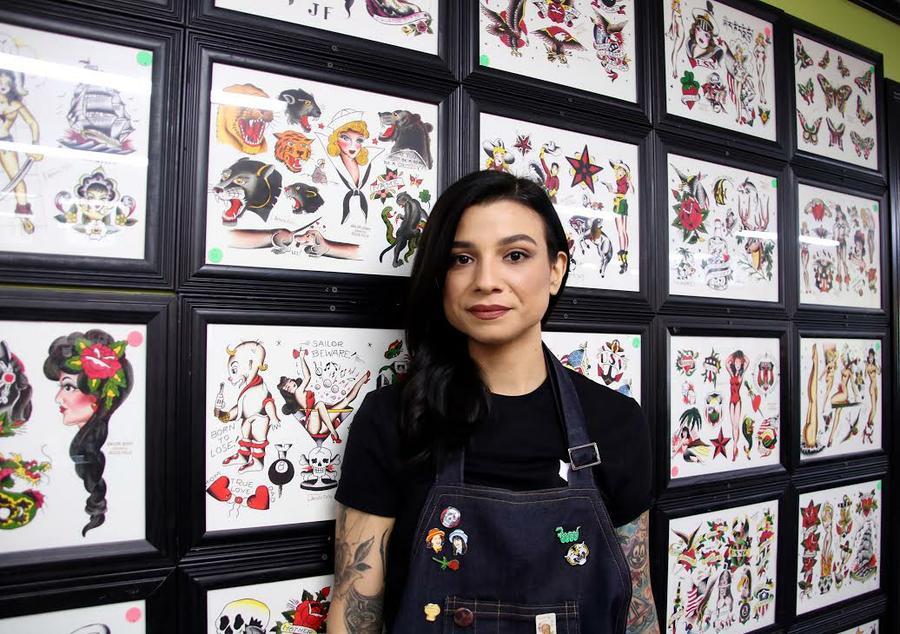It is tradition for women in northern Philippines to tattoo their young daughters. They believe it enhances their beauty and allows their body to tell a unique story. At the age of 15, tattoo artist Felix Garcia repped blue hair when she got her first “straight edge” tattoo.
“My decoration started as a way to say I’m a part of this culture and this group, and I want everyone to know about it,” Garcia said. “I still remember walking around the mall at 15 with people staring at me because of my hair and tattoos. People were tripping that my mom let me do that. So that’s what I began to use it for. I felt more stoked to express myself this way.”
The punk rock scene of Los Angeles and Las Vegas drew Garcia into a culture she would never untangle herself from. Years later, Garcia would be back in Vegas fighting for an apprenticeship at a local tattoo shop, one similar to where she works now at Tattoo You in Columbia. But at that time, the rebellious, unapologetic community of teens screaming on stages is where Garcia established herself free of judgement and was exposed to the art of not giving a damn.
Garcia thrived in the punk community because of its authenticity and art-oriented vibe, but when she decided to become a tattooer at the age of 24, she was in uncharted territory.
“I basically had to take everything I knew about art and throw it in the garbage because it’s not at all the same,” Garcia said.
Tattooing is a very unique form of art because it generally lacks the acceptance of subjectivity. Basically anyone can tell if a permanent piece of ink is good or bad, so the fundamentals of the practice are crucial to master. There isn’t a formal schooling process for tattooing, so artists rely on shadowing other tattooers in their shops, as well as painting and drawing frequently.
“To get into the tattoo community, you can’t just come in and say, ‘Hey, I want to be a tattooer here’s my book,’” Garcia said. “You have to prove you want it in a lot of ways. They also teach you how to have grit and stand your ground. You have to be able to defend yourself. That’s what they’re prepping you for when they’re cleaning their tubes and talking shit. It’s like the military where they want to break you down and build you back up to make you a better artist mentally.”
Whether giving or receiving, this community demands toughness and confidence because the reward is worth the pain. The numbers of Americans with tattoos is growing by the year. With three out of 10 Americans having a tattoo in 2016, according to a The Harris Poll study, the community is growing faster than it ever has in history.
Along with the numbers, America’s perception of tattoo culture is also changing. From military men to soccer moms, now more than ever people are inducting themselves into the community by committing to a permanent form of expression. Garcia feels strongly about how inclusive this community is evolving to be.
“We sometimes do memorial tattoos,” Garcia said. “Families are coming in; they’ve just lost somebody and before they have the wake or funeral they’re getting this person memorialized on their body. I feel so honored to be a part of that. It’s so much respect I gain from other people and myself, letting me be a part of their family in that way. It reminds me this is why I’m doing this. Sometimes they’re grandparents age and sometimes it’s a 13-year-old kid who committed suicide. It’s like, dude this is real; this is happening.”
Whether it’s for decoration or symbolism, getting a tattoo is an intimate and powerful experience for both artist and client. Regardless of the reason, tattoos are unique because they are a commitment to art. They demand self-confidence because they aren’t going away. People make the choice to get what they love and have to own it.
Strength often comes from the willingness to be vulnerable and wear your heart, or ink, on your sleeve. This element of tattooing makes the art unique to other forms of self-expression. So, when clients come to Garcia for a cover-up, she complies but often aims to redirect their mentality.
“We do quite a lot of cover-ups, and sometimes the tattoos that people are trying to cover up are cool, and I always tell them whether you like it or not, this will always take you back to a time in your life,” Garcia said. “Just like songs or smells hold memories, I can look back at some of my own tattoos and remember exactly where I was state of mind: where I was living, who I was hanging out with, etc. It’s cool to have something on your body that you can look down at and remember.”
Tattooing is the art of impenitence. It’s allowing others to see who you are without apologizing for it. Akin to punk rockers screaming on a stage, tattooing is going through pain and in return, owning it. Like the punk rock girl with blue hair who now tells other people’s stories and makes the community more beautiful and fearless one tattoo at a time.
_Edited by Claire Colby | [email protected]_








